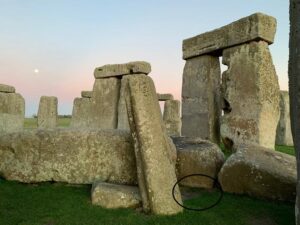
CURTIN UNIVERSITY—New research led by Curtin University has revealed Stonehenge’s monumental six-tonne Altar Stone, long believed to originate from Wales, actually hails from Scotland.
Furthermore, the findings point to the existence of unexpectedly advanced transport methods and societal organisation at the time of the stone’s arrival at its current location in southern England about 5000 years ago.
Curtin researchers studied the age and chemistry of mineral grains within fragments of the Altar Stone, which is a 50cm thick sandstone block measuring 5 x 1 metres, that sits at the centre of Stonehenge’s iconic stone circle in Wiltshire.
Lead author PhD student Anthony Clarke from the Timescales of Mineral Systems Group within Curtin’s School of Earth and Planetary Sciences said analysis of the age and chemical composition of minerals within fragments of the Altar Stone matched it with rocks from northeast Scotland, while also clearly differentiating them from Welsh bedrock.
“Our analysis found specific mineral grains in the Altar Stone are mostly between 1000 to 2000 million years old, while other minerals are around 450 million years old,” Mr Clarke said.
“This provides a distinct chemical fingerprint suggesting the stone came from rocks in the Orcadian Basin, Scotland, at least 750 kilometres away from Stonehenge.
“Given its Scottish origins, the findings raise fascinating questions, considering the technological constraints of the Neolithic era, as to how such a massive stone was transported over vast distances around 2600 BC.
“This discovery also holds personal significance for me. I grew up in the Mynydd Preseli, Wales, where some of Stonehenge’s stones came from. I first visited Stonehenge when I was one year old and now at 25, I returned from Australia to help make this scientific discovery – you could say I’ve come full circle at the stone circle.”
Study co-author Professor Chris Kirkland, also from the Timescales of Mineral Systems Group at Curtin, said the findings had significant implications for understanding ancient communities, their connections, and their transportation methods.
“Our discovery of the Altar Stone’s origins highlights a significant level of societal coordination during the Neolithic period and helps paint a fascinating picture of prehistoric Britain,” Professor Kirkland said.
“Transporting such massive cargo overland from Scotland to southern England would have been extremely challenging, indicating a likely marine shipping route along the coast of Britain.
“This implies long-distance trade networks and a higher level of societal organisation than is widely understood to have existed during the Neolithic period in Britain.”
Funded by an Australian Research Council Discovery Project, the research was performed in collaboration with Aberystwyth University, The University of Adelaide and University College London.
Co-author Professor Richard Bevins from Aberystwyth University said the findings overturned what had been thought for the past century.
“We have succeeded in working out, if you like, the age and chemical fingerprints of perhaps one of the most famous of stones in the world-renowned ancient monument,” Professor Bevins said.
“While we can now say that this iconic rock is Scottish and not Welsh, the hunt will still very much be on to pin down where exactly in the north-east of Scotland the Altar Stone came from.”
Co-author Dr Robert Ixer of the UCL Institute of Archaeology said the findings were genuinely shocking, but if plate tectonics and atomic physics were correct, then the Altar Stone is Scottish.
“The work prompts two important questions: why and exactly how was the Altar Stone transported from the very north of Scotland, a distance of more than 700 kilometres, to Stonehenge?”
Curtin Vice-Chancellor Professor Harlene Hayne said much of the research and analysis done by Mr Clarke and Professor Kirkland was undertaken at the University’s renowned John de Laeter Centre.
“This fascinating study is another example of the stellar work being undertaken by Curtin University’s Timescales of Mineral Systems Group with the John de Laeter Centre, using state-of-the-art equipment in our GeoHistory Facility that supports important minerals research,” Professor Hayne said.
“It offers specialist mass spectrometers which are used to examine the composition of materials such as rock-forming minerals, archaeological artefacts, meteorites, ceramics and even biological substances such as teeth, bones and shell.
“Ongoing investment is required to maintain cutting-edge facilities like this, which are crucial for attracting the world’s best minds. In this case, we are delighted that our outstanding research reputation and facilities led PhD student Anthony Clarke to travel 15,000 kilometres from his home in Wales to study at Curtin and make this significant finding.”
Mr Clarke said he chose Curtin for his PhD because it also offered the chance to work alongside renowned researchers, such as Professor Kirkland.
“Curtin has given us the freedom and independence to explore fascinating work, such as Stonehenge and access to the world’s most advanced equipment and expert staff means I can complete all my work there,” Mr Clarke said.
“Western Australia itself as home to the oldest minerals on Earth, is an outstanding natural laboratory. So I’m very grateful to have had the opportunity to do this research in this outstanding place.”
The full study titled ‘A Scottish Provenance for the Altar Stone of Stonehenge’ is published in the journal Nature.
__________________________

The Altar Stone at Stonehenge. Credit: English Heritage
__________________________
Article Source: Curtin University news release.
*A Scottish Provenance for the Alatar Stone of Stonehenge, Nature, 14 August, 2024.
__________________________
Advertisement

EXPLORE THE ANCIENT ETRUSCANS IN PERSON!
Experience a unique, up-close-and-personal hike among ancient hilltop towns in central Italy. You will walk the sensational countryside of the regions of Umbria and Tuscany, soaking in important sites attesting to the advanced Etruscan civilization, forerunners of the ancient Romans; imposing architectural and cultural remains of Medieval Italy; local food and drink; and perhaps best of all — spectacular scenic views! Join us in this collaborative event for the trip of a lifetime!




